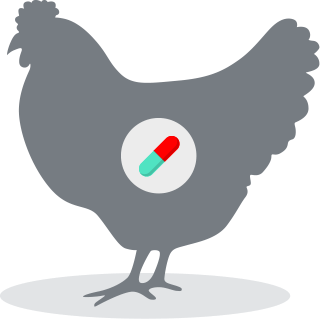Antibiotic use reduces bacteria
The use of antibiotics in an animal leads to an overall decrease in bacteria, improving food safety and animal health. The issue of resistance relates to any remaining bacteria, which may have a higher likelihood of resistance to the specific class of antibiotic used.
Cooking meat to the proper temperature kills all bacteria, eliminating the possibility of exposure to resistant bacteria. It is also important to handle raw meat properly to prevent spreading bacteria to other foods.
It is important to begin with a common understanding of the term antibiotic resistance. You may have heard the term antibiotic residue and wondered whether it is related to antibiotic resistance. The two are not related. Antibiotic resistance refers to bacteria that evolve to the point they are not easily killed by antibiotics. Antibiotic residue refers to molecules that remain in meat from animals that have been treated with antibiotics. There are multiple safeguards in place to ensure meat is safe and does not contain antibiotic residues, including mandatory antibiotic withdrawal periods in animals and routine testing of meat, milk and eggs by the U.S. Department of Agriculture and food companies.
Antibiotics important to human medicine
The animal health community is concerned about the public health risk of antibiotic resistance. Responsible use of antibiotics by doctors and patients, as well as veterinarians and farmers, helps reduce the risk of antibiotic resistance.
The Center for Disease Control (CDC) identified the most concerning public health threats from antibiotic resistant bacteria. None of the most urgent threats have any relation to farm animals. On the broader CDC list, which includes less urgent threats, only two of 18 involve bacteria associated with farm animals.
Although there is broad scientific acknowledgement that the use of antibiotics in people is the primary source of antibiotic resistance, antibiotics must be used responsibly in food animals to minimize agriculture’s contribution to antibiotic resistance.
Limiting use of agricultural antibiotics
Changes voluntarily adopted by the animal health community Jan. 1, 2017, in the United States limit the agricultural use of antibiotics important to human medicine. They can be used only to treat, control and prevent disease in animals – not for growth promotion. Additionally, increased oversight by a veterinarian is required. With this new approach, farmers adjusted their management practices to continue to ensure food safety and animal health while minimizing the risk of antibiotic resistance.
Risk analysis
There remain unanswered questions about the source of human antibiotic resistance.
A study of macrolides concludes there is a 1 in 10 million to 1 in 3 billion chance of treatment failure from antibiotic resistance related to the use of common animal antibiotics, depending upon the bacteria. To put that into context, you are far more likely to die from a dog bite or lightning strike than from treatment failure related to the use of antibiotics in animals.
Sources:
- Public health consequences of macrolide use in food animals: a deterministic risk assessment.
- National Safety Council: Risk of dying from a dog bite is 1:116,448 and from lightning strike is 1:164,968.
A comprehensive 2016 review of 50 studies published in Critical Reviews in Food Science and Nutrition concluded there is an established connection between animal antibiotic use and antibiotic resistance in animals, but no established causal relationship between animal antibiotic use and human resistance related to campylobacter.
Source:
“Effect of Antimicrobial Use in Agricultural Animals on Drug-resistant Foodborne Campylobacteriosis in Humans: A Systematic Literature Review,” M.A. McCrackin, Kristi L. Helke, Ashley M. Galloway, Ann Z. Poole, Cassandra D. Salgado & Bernadette p. Marriott, Critical Reviews in Food Science and Nutrition, Volume 56, 2016 – Issue 13, Pages 2115-2132.

































